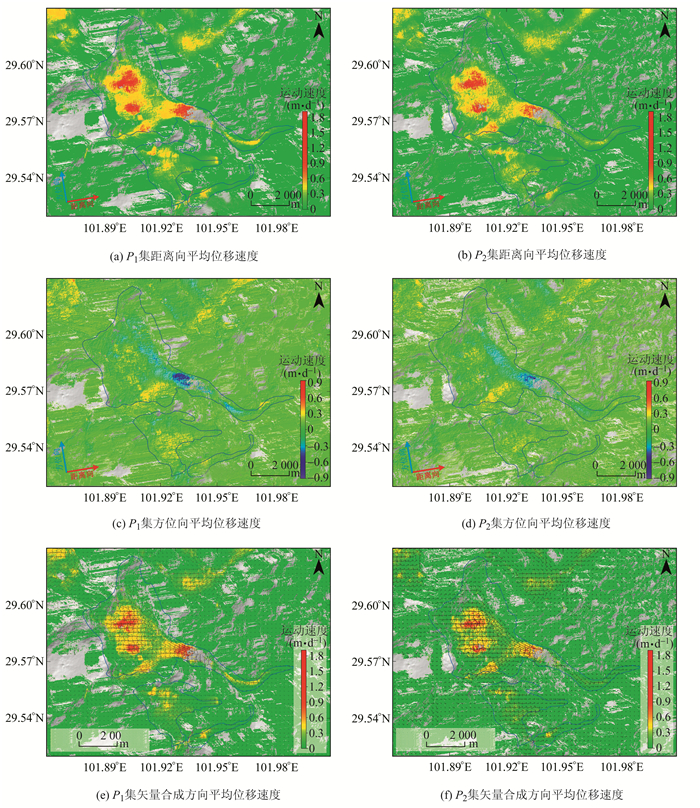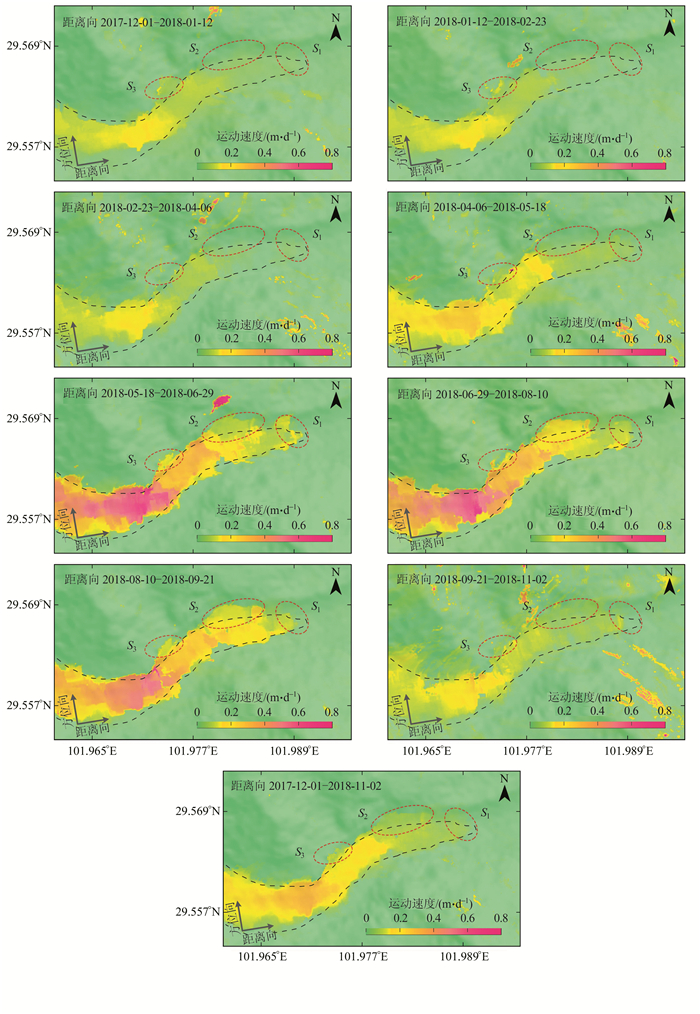Monitoring Dynamics of Hailuogou Glacier and the Secondary Landslide Disasters Based on Combination of Satellite SAR and Ground-Based SAR
-
摘要: 受全球气候变化的影响,近年来中国藏东南及横断山脉多数冰川物质持续亏损、运动速度减缓,导致泥石流、滑坡等灾害频发。为突破光学遥感受气候条件制约的瓶颈,联合卫星合成孔径雷达(synthetic aperture radar,SAR)和地基SAR两种技术手段,选取海螺沟冰川作为典型研究区域,开展时序监测分析。基于对近11 a间获取的38景PALSAR系列影像的像素偏移统计表明,海螺沟1号冰川粒雪盆和冰瀑布上沿区域整体运动最快,最大速度超过2 m/d;在海拔2 900~3 900 m的冰舌区,冰川运动趋缓,速度降至0.1~0.4 m/d;随着季节更替,海螺沟冰川运动速度呈周期性波动,积累区的夏冬两季差异为25%~35%,而冰舌段的差异则高达4倍。在年际变化方面,海螺沟1号冰川的运动速度平均减缓率为每年7.27%,消融区内减缓率高达每年15.57%。同时,使用像素偏移追踪和Stacking-InSAR(interferometric SAR)方法在海螺沟U型谷北坡探明了多处不稳定滑坡体,统计分析表明,此类滑坡运动与冰川消融具有强相关性,滑移速度于每年夏季达到峰值,2018年度最大滑移速度为南北向100 mm/d、东西向50 mm/d。进一步分析地基雷达的高频实时监测数据,确定该滑坡体的滑移速度在2018-07-09达到峰值(150 mm/d),并于随后失稳垮塌,详细展现了整个蠕变致灾过程。相关研究数据及监测结果可为冰冻圈及山地灾害研究提供参考。Abstract: Due to the influence of global climate change, most glaciers in southeastern Tibet and Hengduan Mountains in recent years have been losing weight, deteriorating and thinning, which has caused the variation of glacier movement characteristics, resulting in frequent disasters such as debris flows and landslides. In order to break through the bottleneck of optical remote sensing restricted by climatic conditions, this paper combines satellite and ground-based synthetic aperture radar (SAR) technology and selects Hailuogou Glacier (HLG) basin as a typical research area to carry out time series monitoring and analysis. Firstly, by using 38 SAR images acquired by PALSAR-1/2 satellites from 2007 to 2018, the temporal and spatial variations and local surface displacements of HLG in Gongga Mountain are monitored by using the pixel offset tracking (POT) method. The average velocity of HLG No.1 is slowed down by 7.27% per year in recent years, and the slow-down rate reaches 15.57% per year in the ablation areas. At the same time, several unstable landslides are detected by POT and Stacking-InSAR methods at the moraine embankment on the side of the glacier. Statistical analysis confirms that the movement of such landslides is strongly correlated with the melting of the glacier. The sliding speed reaches its peak in summer every year. The maximum sliding speed in 2018 was 100 mm/d in the north-south direction and 50 mm/d in the east-west direction. Subsequently, by utilization of the high-frequency real-time monitoring data of ground-based radar, it is further determined that the sliding speed reaches its peak value of 150 mm/d on July 9, 2018, and abnormal fluctuations occur with the subsequent collapse, which shows in detail the whole process of landslide creep to result in disasters. Relevant research data and the monitoring results can provide a reference for the study of the cryosphere and mountain hazards.
-
Keywords:
- Hailuogou Glacier /
- pixel offset tracking /
- ground-based SAR /
- glacier movement /
- landslide
-
致谢: 感谢日本宇宙航空研究开发机构日本对地观测中心提供的ALOS/PALSAR-1和ALOS/PALSAR-2数据支持,感谢贡嘎山高山生态系统观测试验站提供的气象数据。
-
表 1 卫星SAR影像数据成像时间及POT组合属性信息
Table 1 Imaging Time of the Satellite SAR Images and the Attribute Information of the POT Combinations
卫星 序号 主影像
成像时间从影像
成像时间时间
基线/d空间
基线/m1 2007-01-09 2007-07-12 184 2 403 2 2007-07-12 2007-08-27 46 263 3 2007-08-27 2007-10-12 46 329 4 2007-10-12 2008-01-12 92 398 5 2008-01-12 2008-04-13 92 781 6 2008-04-13 2008-07-14 92 -2 670 7 2008-07-14 2008-08-29 46 -2 067 8 2008-08-29 2008-11-29 92 1 150 9 2008-11-29 2009-03-01 92 482 P1 10 2009-03-01 2009-09-01 184 948 11 2009-09-01 2009-10-17 46 269 12 2009-10-17 2010-01-17 92 270 13 2010-01-17 2010-03-04 46 449 14 2010-03-04 2010-07-20 138 328 15 2010-07-20 2010-09-04 46 271 16 2010-09-04 2010-10-20 46 92 17 2010-10-20 2010-12-05 46 21 18 2010-12-05 2011-01-20 46 388 19 2011-01-20 2011-03-07 46 496 20 2017-12-01 2018-01-12 42 186 21 2018-01-12 2018-02-23 42 -120 P2 22 2018-02-23 2018-04-06 42 -238 SM1 23 2018-04-06 2018-05-18 42 78 24 2018-05-18 2018-06-29 42 8 25 2018-06-29 2018-08-10 42 -73 26 2018-08-10 2018-09-21 42 225 27 2014-09-26 2014-12-05 70 14 28 2014-12-05 2015-09-25 294 -19 P2 29 2015-09-25 2015-12-04 70 40 SM3 30 2015-12-04 2016-02-12 70 -8 31 2016-02-12 2016-07-15 154 -101 32 2016-07-15 2016-09-23 70 49 33 2016-09-23 2016-12-02 70 25 34 2016-12-02 2017-02-10 70 -69 35 2017-02-10 2018-11-02 630 86 异源 36 2016-12-02 2017-12-01 - - 37 2018-09-21 2018-11-02 - - 说明:P1表示ALOS/PALSAR-1影像对子集,P2表示ALOS/PALSAR-2影像对子集 -
[1] IPCC. Climate Change 2014: The Physical Science Basis. Report of Working Group of the Intergovernmental Panel on Climate Change[M]. Cambridge: Cambridge University Press, 2014
[2] Wang W, Yao T, Gao Y, et al. A First-Order Method to Identify Potentially Dangerous Glacial Lakes in a Region of the Southeastern Tibetan Plateau[J].Mountain Research and Development, 2011, 31(2): 122-130 doi: 10.1659/MRD-JOURNAL-D-10-00059.1
[3] Wang W, Yao T, Yang X.Variations of Glacial Lakes and Glaciers in the Boshula Mountain Range, Southeast Tibet, from the 1970s to 2009[J]. Annals of Glaciology, 2011, 52(58): 9-17 doi: 10.3189/172756411797252347
[4] 童立强, 涂杰楠, 裴丽鑫, 等.雅鲁藏布江加拉白垒峰色东普流域频繁发生碎屑流事件初步探讨[J].工程地质学报, 2018, 26(6): 1 552-1 561 http://d.old.wanfangdata.com.cn/Periodical/gcdzxb201806018 Tong Liqiang, Tu Jienan, Pei Lixin, et al.Preliminary Discussion of the Frequently Debris Flow Events in Sedongpu Basin at Gyalaperi Peak, Yarlung Zangbo River[J]. Journal of Engineering Geology, 2018, 26(6): 1 552-1 561 http://d.old.wanfangdata.com.cn/Periodical/gcdzxb201806018
[5] 姚檀栋, 秦大河, 沈永平, 等.青藏高原冰冻圈变化及其对区域水循环和生态条件的影响[J].自然杂志, 2013, 35(3): 179-186 http://d.old.wanfangdata.com.cn/Periodical/zrzz201303005 Yao Tandong, Qin Dahe, Shen Yongping, et al. Cryospheric Changes and Their Impacts on Regional Water Cycle and Ecological Conditions in the Qinghai-Tibetan Plateau[J]. Chinese Journal of Nature, 2013, 35(3): 179-186 http://d.old.wanfangdata.com.cn/Periodical/zrzz201303005
[6] 杜建括, 何元庆, 李双, 等.横断山区典型海洋型冰川物质平衡研究[J].地理学报, 2015, 70(9):1 415-1 422 http://d.old.wanfangdata.com.cn/Periodical/dlxb201509005 Du Jiankuo, He Yuanqing, Li Shuang, et al. Mass Balance of a Typical Monsoonal Temperate Glacier in Hengduan Mountains Region[J]. Acta Geographica Sinica, 2015, 70(9): 1 415-1 422 http://d.old.wanfangdata.com.cn/Periodical/dlxb201509005
[7] 施雅风, 刘时银.中国冰川对21世纪全球变暖响应的预估[J].科学通报, 2000, 45(4): 434-438 doi: 10.3321/j.issn:0023-074X.2000.04.021 Shi Yafeng, Liu Shiyin. Estimate of the Response of Glaciers in China to the Global Warming-up in the 21th Century[J]. Chinese Science Bulletin, 2000, 45(4): 434-438 doi: 10.3321/j.issn:0023-074X.2000.04.021
[8] Braithwaite R J, Zhang Y. Sensitivity of Mass Balance of Five Swiss Glaciers to Temperature Changes Assessed by Tuning a Degree-Day Model[J]. Journal of Glaciology, 2000, 46(152): 7-14 doi: 10.3189/172756500781833511
[9] 苏珍, 宋国平, 曹真堂.贡嘎山海螺沟冰川的海洋性特征[J].冰川冻土, 1996, 18(S1):51-59 http://www.wanfangdata.com.cn/details/detail.do?_type=perio&id=QK199600171641 Su Zhen, Song Guoping, Cao Zhentang. Maritime Characteristics of Hailuogou Glacier in the Gongga Mountains[J].Journal of Glaciology and Geocryo-logy, 1996, 18(S1):51-59 http://www.wanfangdata.com.cn/details/detail.do?_type=perio&id=QK199600171641
[10] 刘巧, 张勇.贡嘎山海洋型冰川监测与研究:历史, 现状与展望[J].山地学报, 2017, 35(5): 717-726 http://d.old.wanfangdata.com.cn/Periodical/sdxb201705013 Liu Qiao, Zhang Yong. Studies on the Dynamics of Monsoonal Temperate Glaciers in Mt.Gongga:A Review[J].Mountain Research, 2017, 35(5): 717-726 http://d.old.wanfangdata.com.cn/Periodical/sdxb201705013
[11] 刘时银, 姚晓军, 郭万钦, 等.基于第二次冰川编目的中国冰川现状[J].地理学报, 2015, 70(1): 3-16 http://d.old.wanfangdata.com.cn/Periodical/dlxb201501001 Liu Shiyin, Yao Xiaojun, Guo Wanqin, et al. The Contemporary Glaciers in China Based on the Second Chinese Glacier Inventory[J].Acta Geographica Sinica, 2015, 70(1): 3-16 http://d.old.wanfangdata.com.cn/Periodical/dlxb201501001
[12] Dehecq A, Gourmelen N, Gardner A S, et al. Twenty-First Century Glacier Slowdown Driven by Mass Loss in High Mountain Asia[J].Nature Geoscience, 2019, 12(1): 22, doi: 10.1038/s41561-018-0271-9
[13] Altena B, Scambos T, Fahnestock M, et al. Extracting Recent Short-Term Glacier Velocity Evolution Over Southern Alaska and the Yukon from a Large Collection of Landsat Data[J]. The Cryosphere, 2019, 13(3):795-814 doi: 10.5194/tc-13-795-2019
[14] Scherler D, Leprince S, Strecker M R. Glacier-Surface Velocities in Alpine Terrain from Optical Satellite Imagery-Accuracy Improvement and Quality Assessment[J]. Remote Sensing of Environment, 2008, 112(10): 3 806-3 819 doi: 10.1016/j.rse.2008.05.018
[15] Dehecq A, Gourmelen N, Trouvé E. Deriving Large-Scale Glacier Velocities from a Complete Satellite Archive: Application to the Pamir-Karakoram-Himalaya[J]. Remote Sensing of Environment, 2015, 162: 55-66 doi: 10.1016/j.rse.2015.01.031
[16] 周志伟, 鄢子平, 刘苏, 等.永久散射体与短基线雷达干涉测量在城市地表形变中的应用[J].武汉大学学报·信息科学版, 2011, 36(8): 928-931 http://ch.whu.edu.cn/CN/abstract/abstract635.shtml Zhou Zhiwei, Yan Ziping, Liu Su, et al. Persistent Scatterers and Small Baseline SAR Interferometry for City Subsidence Mapping: A Case Study in Panjin, China[J].Geomatics and Information Science of Wuhan University, 2011, 36(8): 928-931 http://ch.whu.edu.cn/CN/abstract/abstract635.shtml
[17] Franceschetti G, Lanari R. Synthetic Aperture Radar Processing[M]. Boca Raton:CRC Press, 2018
[18] 周春霞, 鄂栋臣, 廖明生. InSAR用于南极测图的可行性研究[J].武汉大学学报·信息科学版, 2004, 29(7): 619-623 http://ch.whu.edu.cn/CN/abstract/abstract4513.shtml Zhou Chunxia, E Dongchen, Liao Mingsheng. Feasibility of InSAR Application to Antarctic Mapping[J]. Geomatics and Information Science of Wuhan University, 2004, 29(7): 619-623 http://ch.whu.edu.cn/CN/abstract/abstract4513.shtml
[19] 邓方慧, 周春霞, 王泽民, 等.利用偏移量跟踪测定Amery冰架冰流汇合区的冰流速[J].武汉大学学报·信息科学版, 2015, 40(7): 901-906 http://ch.whu.edu.cn/CN/abstract/abstract3296.shtml Deng Fanghui, Zhou Chunxia, Wang Zemin, et al. Ice-Flow Velocity Derivation of the Confluence Zone of the Amery Ice Shelf Using Offset-Tracking Method[J]. Geomatics and Information Science of Wuhan University, 2015, 40(7): 901-906 http://ch.whu.edu.cn/CN/abstract/abstract3296.shtml
[20] Berthier E, Vadon H, Baratoux D, et al. Surface Motion of Mountain Glaciers Derived from Satellite Optical Imagery[J].Remote Sensing of Environment, 2005, 95(1): 14-28 doi: 10.1016/j.rse.2004.11.005
[21] 何元庆, 张忠林, 姚檀栋, 等.中国季风温冰川区近代气候变化与冰川动态[J].地理学报, 2003, 58(4):550-558 doi: 10.3321/j.issn:0375-5444.2003.04.009 He Yuanqing, Zhang Zhonglin, Yao Tandong, et al. Modern Changes of the Climate and Glaciers in China's Monsoonal Temperate Glacier Region[J]. Acta Geographica Sinica, 2003, 58(4): 550-558 doi: 10.3321/j.issn:0375-5444.2003.04.009
[22] 刘巧, 刘时银, 张勇, 等.贡嘎山海螺沟冰川消融区表面消融特征及其近期变化[J].冰川冻土, 2011, 33(2): 227-236 http://d.old.wanfangdata.com.cn/Periodical/bcdt201102001 Liu Qiao, Liu Shiyin, Zhang Yong, et al. Surface Ablation Features and Recent Variation of the Lower Ablation Area of the Hailuogou Glacier, Mt.Gongga[J]. Journal of Glaciology and Geocryology, 2011, 33(2): 227-236 http://d.old.wanfangdata.com.cn/Periodical/bcdt201102001
[23] Liu Q, Liu S, Zhang Y, et al. Recent Shrinkage and Hydrological Response of Hailuogou Glacier, a Monsoon Temperate Glacier on the East Slope of Mount Gongga, China[J]. Journal of Glaciology, 2010, 56(196): 215-224 doi: 10.3189/002214310791968520
[24] 李宗省, 何元庆, 贾文雄, 等.全球变暖背景下海螺沟冰川近百年的变化[J].冰川冻土, 2009, 31(1):75-81 http://d.old.wanfangdata.com.cn/Periodical/bcdt200901011 Li Zongxing, He Yuanqing, Jia Wenxiong, et al. Changes in Hailuogou Glacier During the Recent 100 Years Under Global Warming[J]. Journal of Glaciology and Geocryology, 2009, 31(1): 75-81 http://d.old.wanfangdata.com.cn/Periodical/bcdt200901011
[25] 刘云华, 屈春燕, 单新建.基于SAR影像偏移量获取汶川地震二维形变场[J].地球物理学报, 2012, 55(10): 3 296-3 306 http://d.old.wanfangdata.com.cn/Periodical/dqwlxb201210012 Liu Yunhua, Qu Chunyan, Shan Xinjian. Two-Dimensional Displacement Field of the Wenchuan Earthquake Inferred from SAR Intensity Offset-Tacking[J]. Chinese Journal of Geophysics, 2012, 55(10): 3 296-3 306 http://d.old.wanfangdata.com.cn/Periodical/dqwlxb201210012
[26] Shi X, Zhang L, Balz T, et al. Landslide Deformation Monitoring Using Point-Like Target Offset Tracking with Multi-mode High-Resolution TerraSAR-X Data[J]. ISPRS Journal of Photogrammetry and Remote Sensing, 2015, 105: 128-140 doi: 10.1016/j.isprsjprs.2015.03.017
[27] Michel R, Avouac J P, Taboury J. Measuring Ground Displacements from SAR Amplitude Images: Application to the Landers Earthquake[J]. Geophysical Research Letters, 1999, 26(7): 875-878 doi: 10.1029/1999GL900138
[28] Pathier E, Fielding E J, Wright T J, et al. Displacement Field and Slip Distribution of the 2005 Kashmir Earthquake from SAR Imagery[J].Geophysical Research Letters, 2006, 33(20): L20310 doi: 10.1029/2006GL027193
[29] Fielding E J, Lundgren P R, Taymaz T, et al. Fault-Slip Source Models for the 2011 M 7.1 Van Earthquake in Turkey from SAR Interferometry, Pixel Offset Tracking, GPS, and Seismic Waveform Analysis[J]. Seismological Research Letters, 2013, 84(4): 579-593 doi: 10.1785/0220120164
[30] Schellenberger T, Dunse T, Kääb A, et al. Surface Speed and Frontal Ablation of Kronebreen and Kongsbreen, NW-Svalbard, from SAR Offset Tracking[J].The Cryosphere Discussions, 2014, 8(6):6 193-6 233 doi: 10.5194/tcd-8-6193-2014
[31] 陈强, 罗容, 杨莹辉, 等.利用SAR影像配准偏移量提取地表形变的方法与误差分析[J].测绘学报, 2015, 44(3): 301-308 http://www.cnki.com.cn/Article/CJFDTOTAL-CHXB201503010.htm Chen Qiang, Luo Rong, Yang Yinghui, et al. Method and Accuracy of Extracting Surface Deformation Field from SAR Image Coregistration[J].Acta Geodaetica et Cartographica Sinica, 2015, 44(3):301-308 http://www.cnki.com.cn/Article/CJFDTOTAL-CHXB201503010.htm
[32] Noferini L, Pieraccini M, Mecatti D, et al. Using GB-SAR Technique to Monitor Slow Moving Landslide[J].Engineering Geology, 2007, 95(3-4): 88-98 doi: 10.1016/j.enggeo.2007.09.002
[33] Nolesini T, Di Traglia F, Del Ventisette C, et al. Deformations and Slope Instability on Stromboli Volcano: Integration of GBInSAR Data and Analog Modeling[J]. Geomorphology, 2013, 180: 242-254 http://cn.bing.com/academic/profile?id=aa9be8615f664ffdfb576518e75620c7&encoded=0&v=paper_preview&mkt=zh-cn
[34] Monserrat O, Crosetto M, Luzi G. A Review of Ground-Based SAR Interferometry for Deformation Measurement[J].ISPRS Journal of Photogrammetry and Remote Sensing, 2014, 93: 40-48 doi: 10.1016/j.isprsjprs.2014.04.001
[35] Yigit E, Demirci S, Unal A, et al. Millimeter-Wave Ground-Based Synthetic Aperture Radar Imaging for Foreign Object Debris Detection: Experimental Studies at Short Ranges[J].Journal of Infrared, Millimeter, and Terahertz Waves, 2012, 33(12): 1 227-1 238 doi: 10.1007/s10762-012-9938-2
[36] Noferini L, Mecatti D, Macaluso G, et al. Monitoring of Belvedere Glacier Using a Wide Angle GB-SAR Interferometer[J].Journal of Applied Geophysics, 2009, 68(2): 289-293 doi: 10.1016/j.jappgeo.2009.02.004
[37] Luzi G, Pieraccini M, Mecatti D, et al. Monitoring of an Alpine Glacier by Means of Ground-Based SAR Interferometry[J]. IEEE Geoscience and Remote Sensing Letters, 2007, 4(3): 495-499 doi: 10.1109/LGRS.2007.898282
-
期刊类型引用(12)
1. 徐燕飞,胡振琪,陈永春,崔瑞豪,苗伟,冯占杰. 基于遥感生态指数的淮南矿区生态环境质量变化分析. 煤炭工程. 2025(01): 195-202 .  百度学术
百度学术
2. 张浩斌,王婉,宋妤婧,苗林光,马超. 基于改进遥感生态指数的干旱内流区生态质量评价——以阴山北麓塔布河流域为例. 生态学报. 2024(02): 523-543 .  百度学术
百度学术
3. 张昊杰,杨立娟,施婷婷,王帅. GF-6 WFV传感器数据的缨帽变换系数推导. 自然资源遥感. 2024(02): 105-115 .  百度学术
百度学术
4. 钟安亚,孙娟,胡春明,谷海红. 基于RSEI的北京王平煤矿生态环境修复效果评估及预测. 矿业安全与环保. 2023(04): 89-96 .  百度学术
百度学术
5. 王新驰,鲁铁定,龚循强,周秀芳. 基于改进遥感生态指数的南昌市生态环境质量监测与评价. 科学技术与工程. 2023(35): 15319-15327 .  百度学术
百度学术
6. 吴群英,苗彦平,陈秋计,侯恩科,李继业. 基于Sentinel-2的荒漠化矿区生态环境监测. 采矿与岩层控制工程学报. 2022(01): 91-98 .  百度学术
百度学术
7. 晏红波,杨志高,卢献健,韦晚秋,黎振宝. 基于改进RSEDI的典型喀斯特地区生态环境质量时空变化. 科学技术与工程. 2022(11): 4646-4653 .  百度学术
百度学术
8. 刘建强,叶小敏,陈鋆. 面向鄱阳湖洪涝风险分析的HY-1C/D卫星CZI影像水体面积与水位关系研究. 华中师范大学学报(自然科学版). 2022(03): 505-512 .  百度学术
百度学术
9. 史宇骁,李阳,孟翊,赵志远,张婷玉,王栋,袁琳. 1989—2020年长江口九段沙湿地格局演变及影响因素. 应用生态学报. 2022(08): 2229-2236 .  百度学术
百度学术
10. 梁齐云,苏涛,张灿,王建,周丽丽. 基于改进遥感生态指数的黄山市生态质量评价研究. 地球物理学进展. 2022(04): 1448-1456 .  百度学术
百度学术
11. 程琳琳,王振威,田素锋,柳亚彤,孙梦尧,杨玉曼. 基于改进的遥感生态指数的北京市门头沟区生态环境质量评价. 生态学杂志. 2021(04): 1177-1185 .  百度学术
百度学术
12. 陈超,陈慧欣,陈东,张自力,张旭锋,庄悦,褚衍丽,陈建裕,郑红. 舟山群岛海岸线遥感信息提取及时空演变分析. 国土资源遥感. 2021(02): 141-152 .  百度学术
百度学术
其他类型引用(21)






 下载:
下载:
















